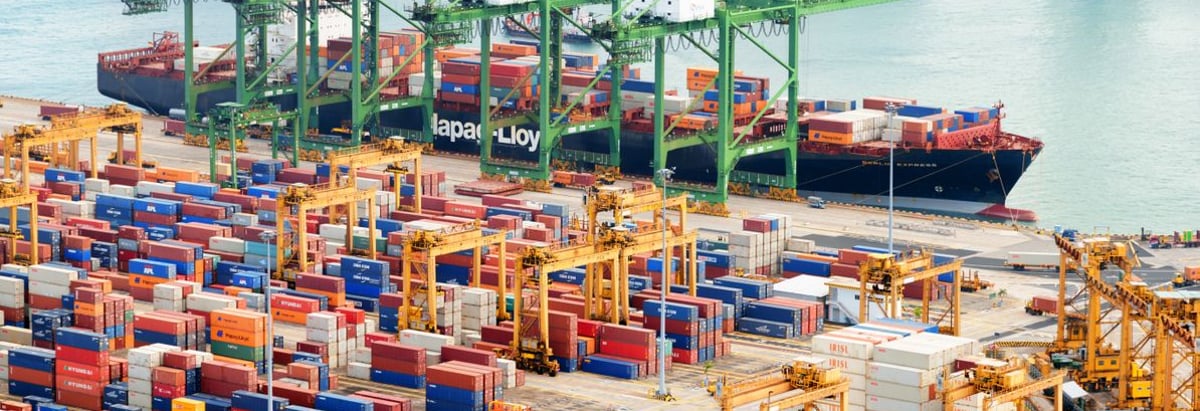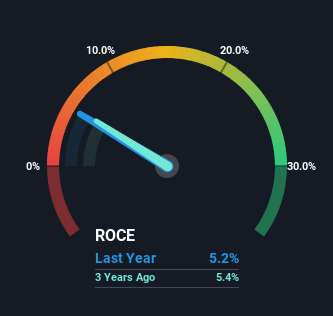- China
- /
- Infrastructure
- /
- SHSE:600190
Here's What To Make Of Jinzhou Port's (SHSE:600190) Decelerating Rates Of Return

If you're not sure where to start when looking for the next multi-bagger, there are a few key trends you should keep an eye out for. Ideally, a business will show two trends; firstly a growing return on capital employed (ROCE) and secondly, an increasing amount of capital employed. This shows us that it's a compounding machine, able to continually reinvest its earnings back into the business and generate higher returns. However, after investigating Jinzhou Port (SHSE:600190), we don't think it's current trends fit the mold of a multi-bagger.
Return On Capital Employed (ROCE): What Is It?
If you haven't worked with ROCE before, it measures the 'return' (pre-tax profit) a company generates from capital employed in its business. The formula for this calculation on Jinzhou Port is:
Return on Capital Employed = Earnings Before Interest and Tax (EBIT) ÷ (Total Assets - Current Liabilities)
0.052 = CN¥508m ÷ (CN¥18b - CN¥7.7b) (Based on the trailing twelve months to September 2023).
So, Jinzhou Port has an ROCE of 5.2%. Even though it's in line with the industry average of 5.3%, it's still a low return by itself.
Check out our latest analysis for Jinzhou Port

Historical performance is a great place to start when researching a stock so above you can see the gauge for Jinzhou Port's ROCE against it's prior returns. If you want to delve into the historical earnings , check out these free graphs detailing revenue and cash flow performance of Jinzhou Port.
So How Is Jinzhou Port's ROCE Trending?
Over the past five years, Jinzhou Port's ROCE and capital employed have both remained mostly flat. This tells us the company isn't reinvesting in itself, so it's plausible that it's past the growth phase. So unless we see a substantial change at Jinzhou Port in terms of ROCE and additional investments being made, we wouldn't hold our breath on it being a multi-bagger.
On a separate but related note, it's important to know that Jinzhou Port has a current liabilities to total assets ratio of 44%, which we'd consider pretty high. This effectively means that suppliers (or short-term creditors) are funding a large portion of the business, so just be aware that this can introduce some elements of risk. Ideally we'd like to see this reduce as that would mean fewer obligations bearing risks.
What We Can Learn From Jinzhou Port's ROCE
We can conclude that in regards to Jinzhou Port's returns on capital employed and the trends, there isn't much change to report on. And in the last five years, the stock has given away 43% so the market doesn't look too hopeful on these trends strengthening any time soon. All in all, the inherent trends aren't typical of multi-baggers, so if that's what you're after, we think you might have more luck elsewhere.
If you want to know some of the risks facing Jinzhou Port we've found 3 warning signs (2 can't be ignored!) that you should be aware of before investing here.
For those who like to invest in solid companies, check out this free list of companies with solid balance sheets and high returns on equity.
New: Manage All Your Stock Portfolios in One Place
We've created the ultimate portfolio companion for stock investors, and it's free.
• Connect an unlimited number of Portfolios and see your total in one currency
• Be alerted to new Warning Signs or Risks via email or mobile
• Track the Fair Value of your stocks
Have feedback on this article? Concerned about the content? Get in touch with us directly. Alternatively, email editorial-team (at) simplywallst.com.
This article by Simply Wall St is general in nature. We provide commentary based on historical data and analyst forecasts only using an unbiased methodology and our articles are not intended to be financial advice. It does not constitute a recommendation to buy or sell any stock, and does not take account of your objectives, or your financial situation. We aim to bring you long-term focused analysis driven by fundamental data. Note that our analysis may not factor in the latest price-sensitive company announcements or qualitative material. Simply Wall St has no position in any stocks mentioned.
About SHSE:600190
Low and slightly overvalued.


